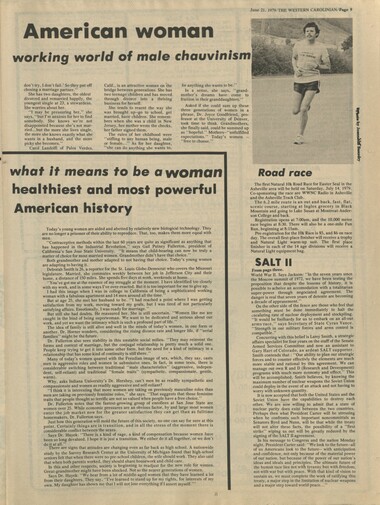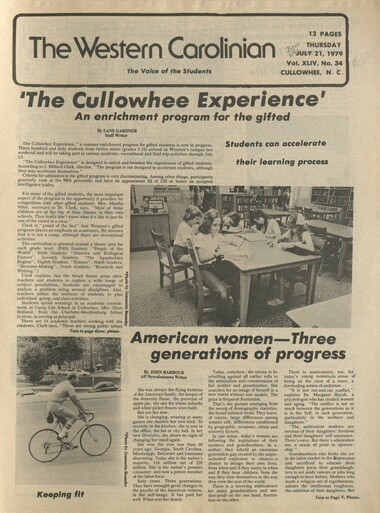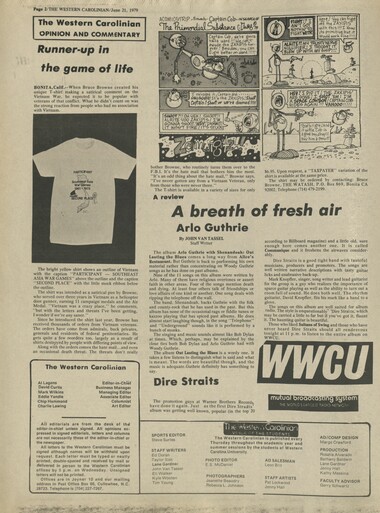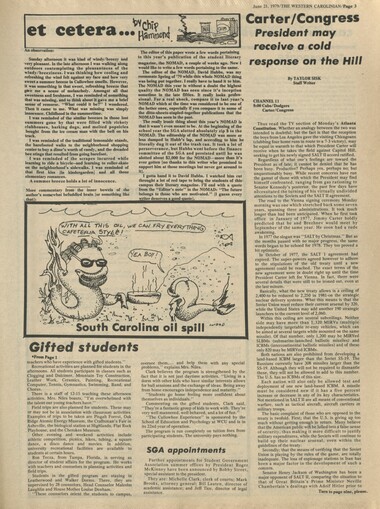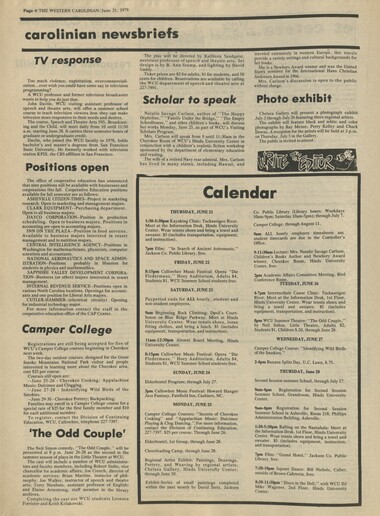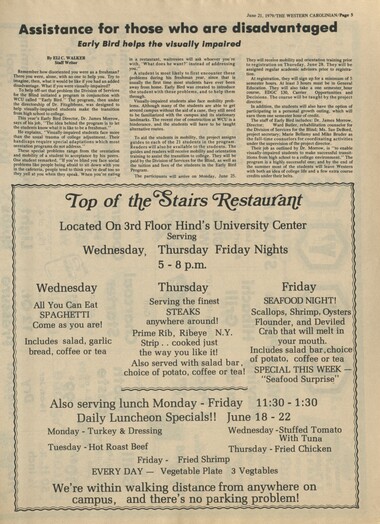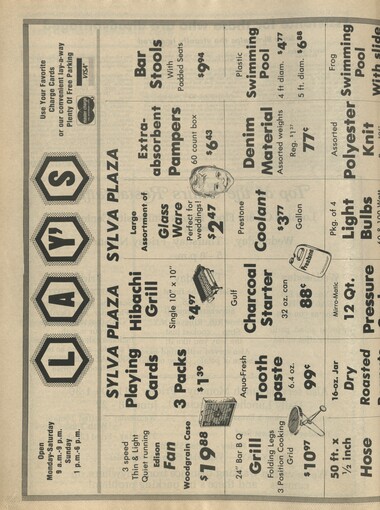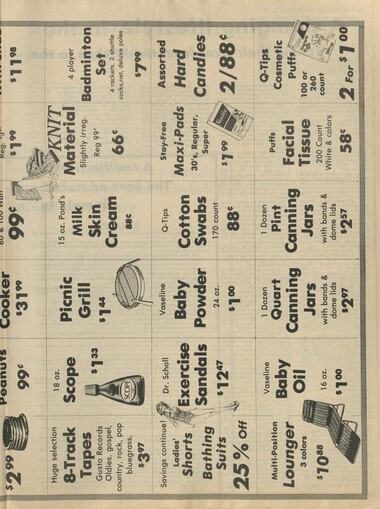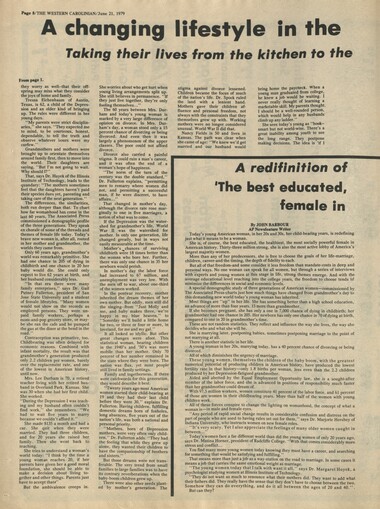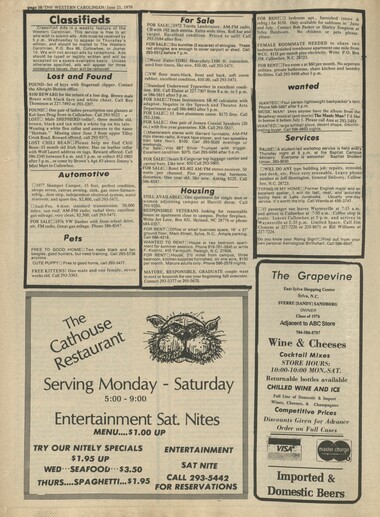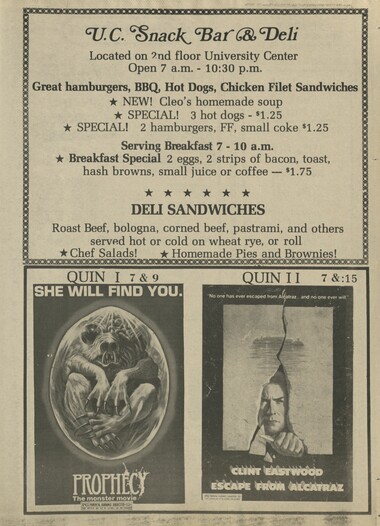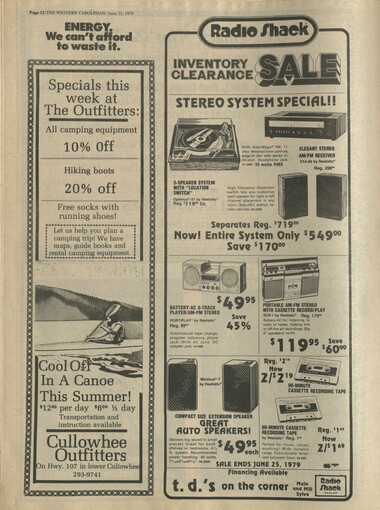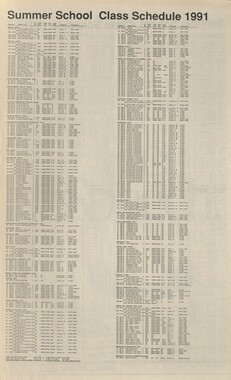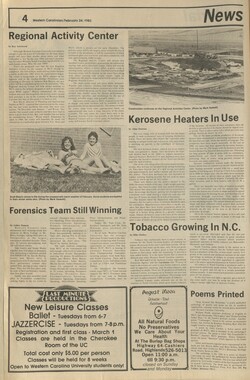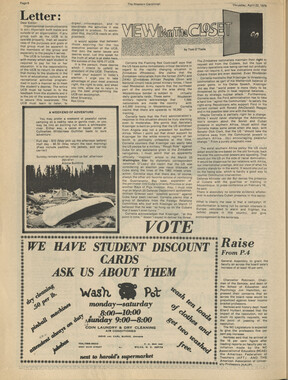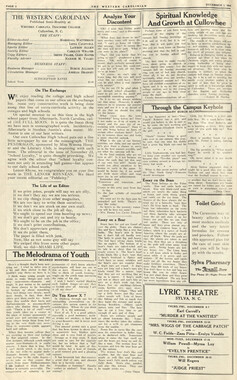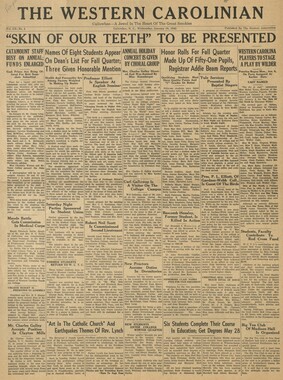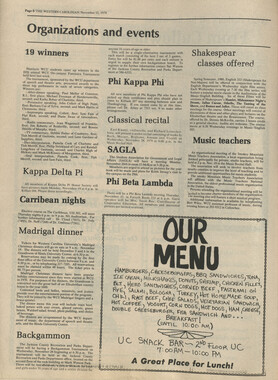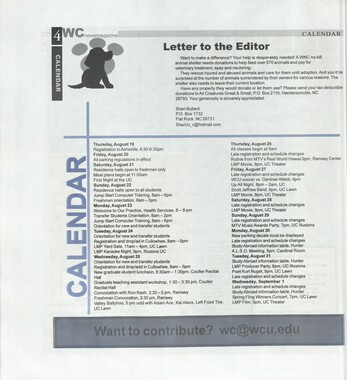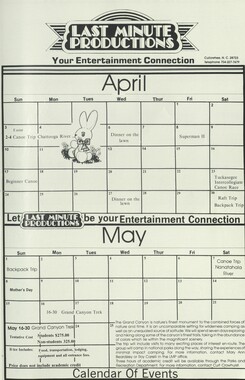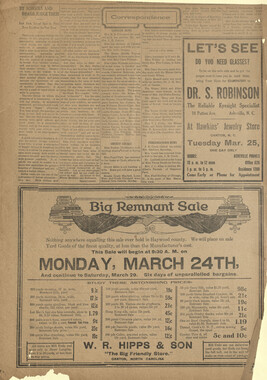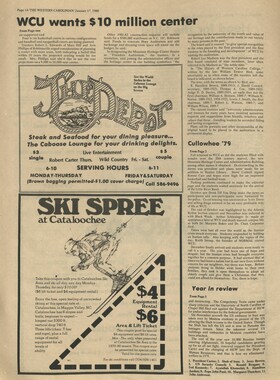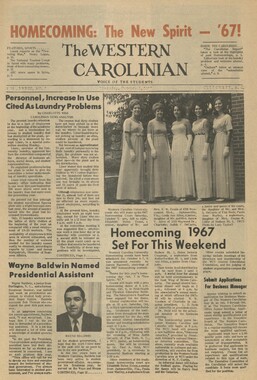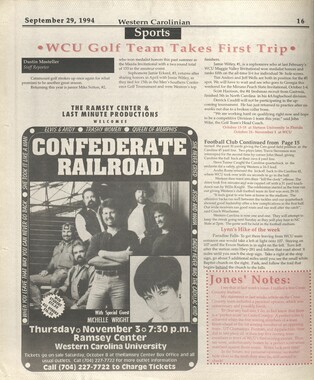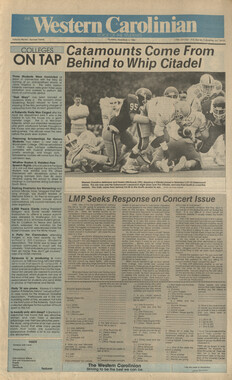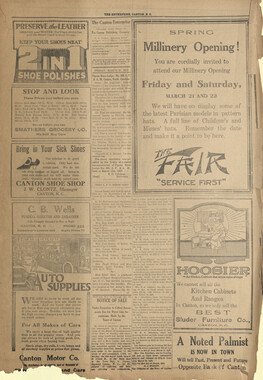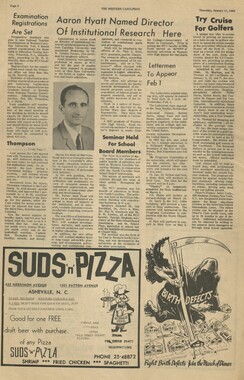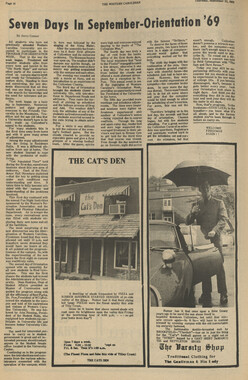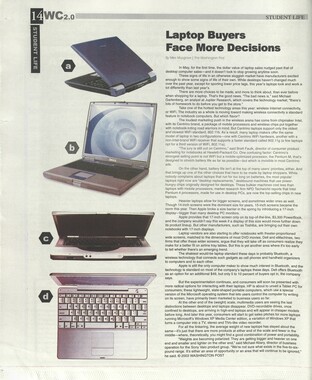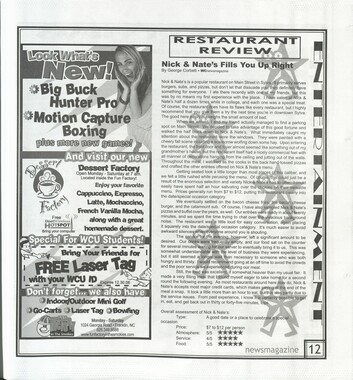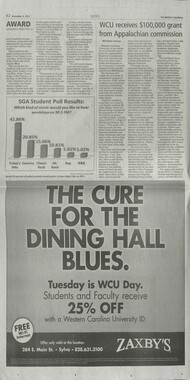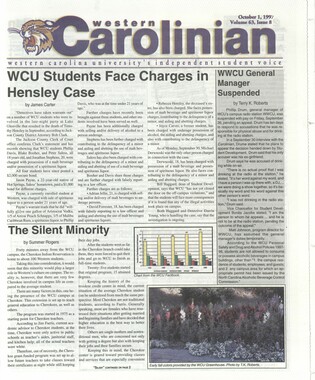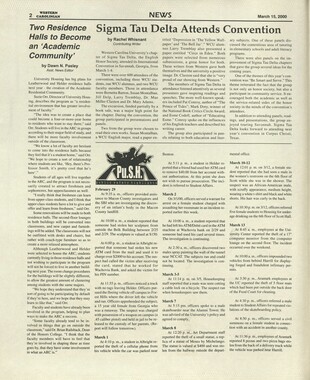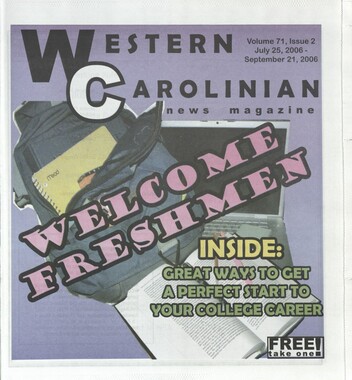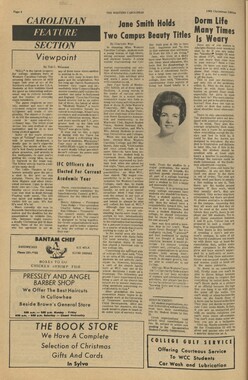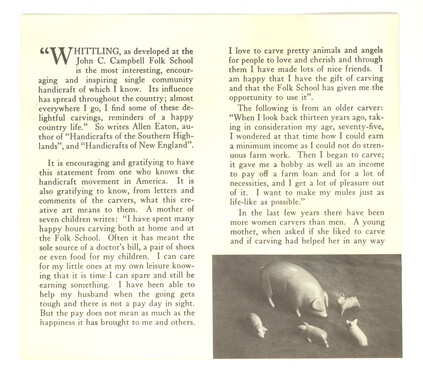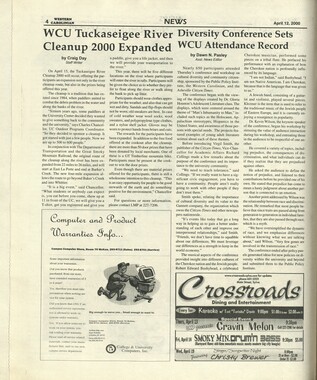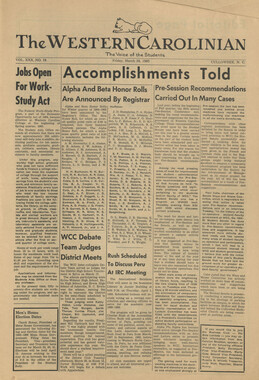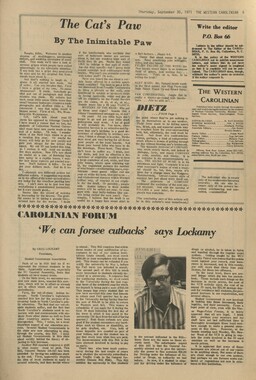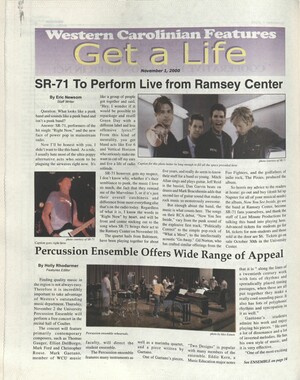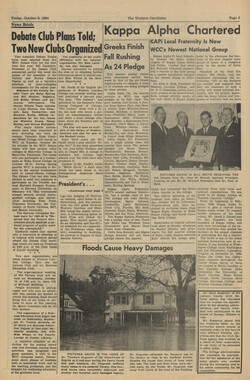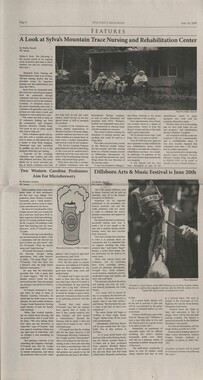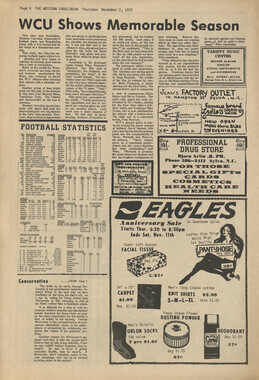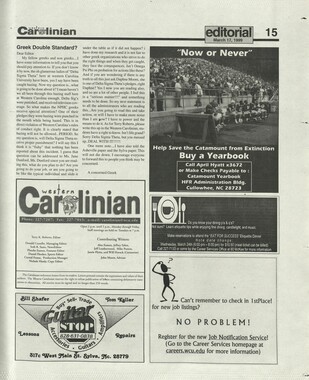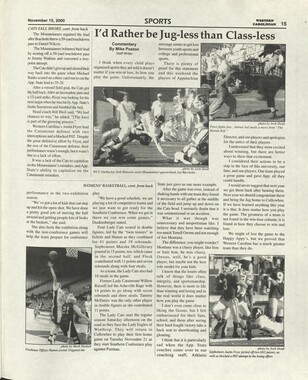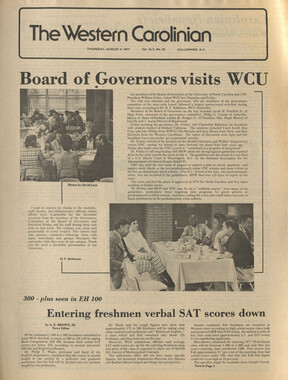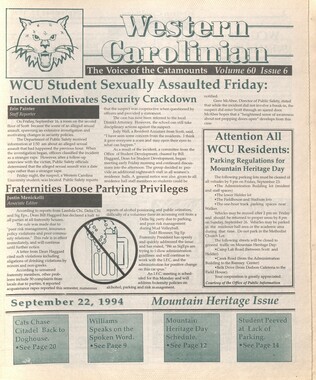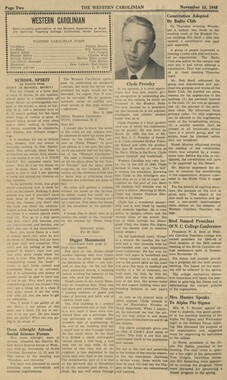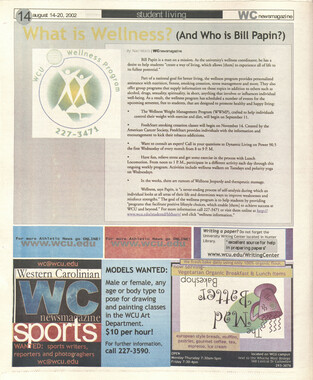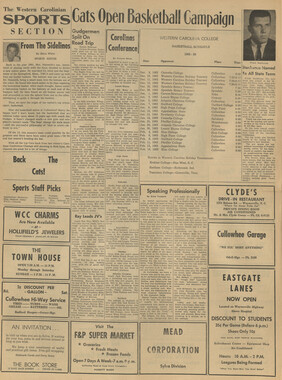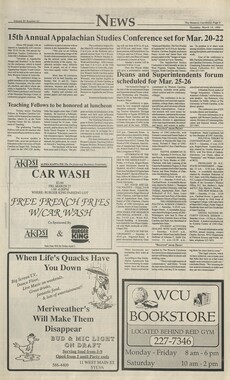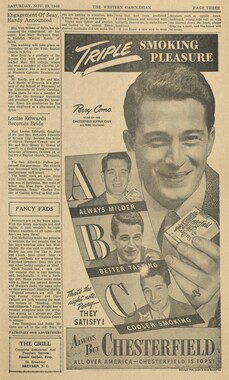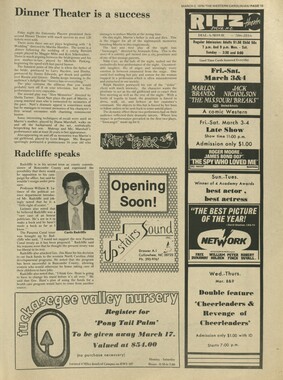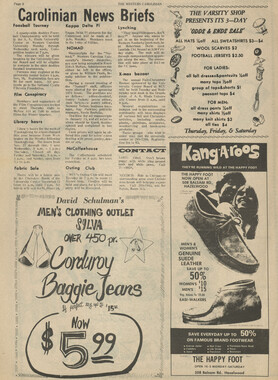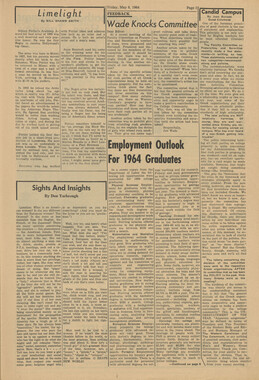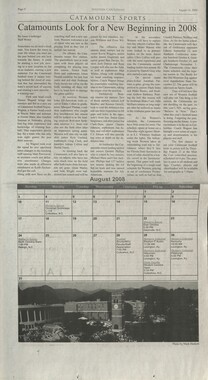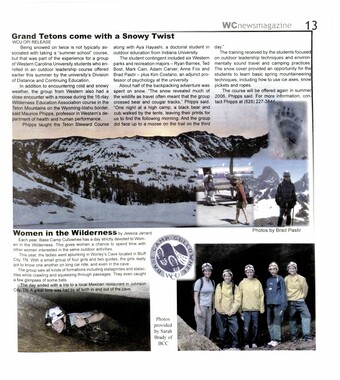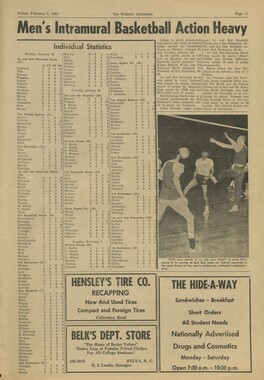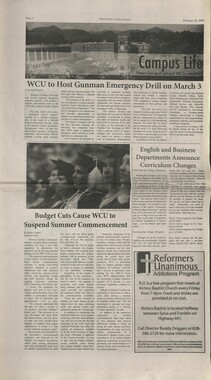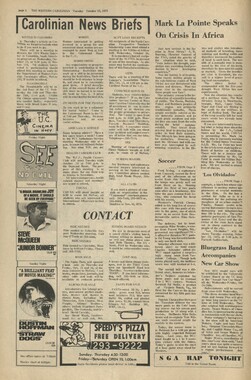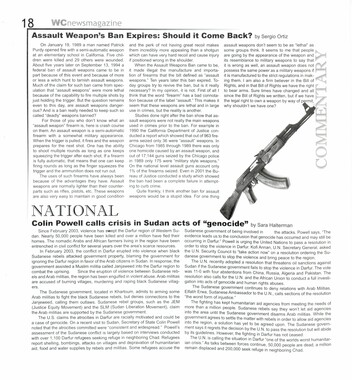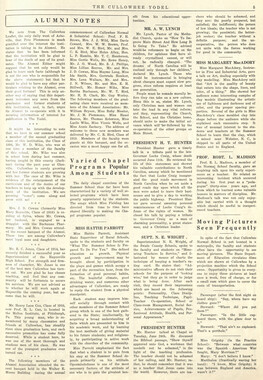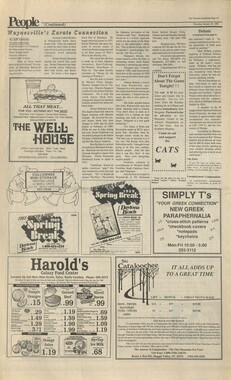Western Carolina University (21)
View all
- Canton Champion Fibre Company (2308)
- Cherokee Traditions (291)
- Civil War in Southern Appalachia (165)
- Craft Revival (1942)
- George Masa Collection (137)
- Great Smoky Mountains - A Park for America (3182)
- Highlights from Western Carolina University (422)
- Horace Kephart (998)
- Journeys Through Jackson (159)
- LGBTQIA+ Archive of Jackson County (90)
- Oral Histories of Western North Carolina (318)
- Picturing Appalachia (6617)
- Stories of Mountain Folk (413)
- Travel Western North Carolina (153)
- Western Carolina University Fine Art Museum Vitreograph Collection (129)
- Western Carolina University Herbarium (92)
- Western Carolina University: Making Memories (738)
- Western Carolina University Publications (2491)
- Western Carolina University Restricted Electronic Theses and Dissertations (146)
- Western North Carolina Regional Maps (71)
- World War II in Southern Appalachia (131)
University of North Carolina Asheville (6)
View all
- Allanstand Cottage Industries (62)
- Appalachian National Park Association (53)
- Bennett, Kelly, 1890-1974 (1463)
- Berry, Walter (76)
- Brasstown Carvers (40)
- Carver, George Washington, 1864?-1943 (26)
- Cathey, Joseph, 1803-1874 (1)
- Champion Fibre Company (233)
- Champion Paper and Fibre Company (297)
- Cherokee Indian Fair Association (16)
- Cherokee Language Program (22)
- Crowe, Amanda (40)
- Edmonston, Thomas Benton, 1842-1907 (7)
- Ensley, A. L. (Abraham Lincoln), 1865-1948 (275)
- Fromer, Irving Rhodes, 1913-1994 (70)
- George Butz (BFS 1907) (46)
- Goodrich, Frances Louisa (120)
- Grant, George Alexander, 1891-1964 (96)
- Heard, Marian Gladys (60)
- Kephart, Calvin, 1883-1969 (15)
- Kephart, Horace, 1862-1931 (313)
- Kephart, Laura, 1862-1954 (91)
- Laney, Gideon Thomas, 1889-1976 (439)
- Masa, George, 1881-1933 (61)
- McElhinney, William Julian, 1896-1953 (44)
- Niggli, Josephina, 1910-1983 (10)
- North Carolina Park Commission (105)
- Osborne, Kezia Stradley (9)
- Owens, Samuel Robert, 1918-1995 (11)
- Penland Weavers and Potters (36)
- Roberts, Vivienne (15)
- Roth, Albert, 1890-1974 (142)
- Schenck, Carl Alwin, 1868-1955 (1)
- Sherrill's Photography Studio (2565)
- Southern Highland Handicraft Guild (127)
- Southern Highlanders, Inc. (71)
- Stalcup, Jesse Bryson (46)
- Stearns, I. K. (213)
- Thompson, James Edward, 1880-1976 (226)
- United States. Indian Arts and Crafts Board (130)
- USFS (683)
- Vance, Zebulon Baird, 1830-1894 (1)
- Weaver, Zebulon, 1872-1948 (58)
- Western Carolina College (230)
- Western Carolina Teachers College (282)
- Western Carolina University (2008)
- Western Carolina University. Mountain Heritage Center (18)
- Whitman, Walt, 1819-1892 (10)
- Wilburn, Hiram Coleman, 1880-1967 (73)
- Williams, Isadora (3)
- Cain, Doreyl Ammons (0)
- Crittenden, Lorraine (0)
- Rhodes, Judy (0)
- Smith, Edward Clark (0)
- Appalachian Region, Southern (3032)
- Asheville (N.C.) (1945)
- Avery County (N.C.) (26)
- Blount County (Tenn.) (200)
- Buncombe County (N.C.) (1680)
- Cherokee County (N.C.) (283)
- Clay County (N.C.) (556)
- Graham County (N.C.) (247)
- Great Smoky Mountains National Park (N.C. and Tenn.) (535)
- Haywood County (N.C.) (3573)
- Henderson County (N.C.) (70)
- Jackson County (N.C.) (4926)
- Knox County (Tenn.) (61)
- Knoxville (Tenn.) (21)
- Lake Santeetlah (N.C.) (14)
- Macon County (N.C.) (421)
- Madison County (N.C.) (216)
- McDowell County (N.C.) (39)
- Mitchell County (N.C.) (135)
- Polk County (N.C.) (35)
- Qualla Boundary (982)
- Rutherford County (N.C.) (78)
- Swain County (N.C.) (2187)
- Transylvania County (N.C.) (270)
- Watauga County (N.C.) (12)
- Waynesville (N.C.) (86)
- Yancey County (N.C.) (72)
- Aerial Photographs (3)
- Aerial Views (60)
- Albums (books) (4)
- Articles (1)
- Artifacts (object Genre) (228)
- Bibliographies (1)
- Biography (general Genre) (2)
- Cards (information Artifacts) (38)
- Clippings (information Artifacts) (193)
- Copybooks (instructional Materials) (3)
- Crafts (art Genres) (622)
- Depictions (visual Works) (21)
- Design Drawings (1)
- Digital Moving Image Formats (2)
- Drawings (visual Works) (185)
- Envelopes (115)
- Exhibitions (events) (1)
- Facsimiles (reproductions) (1)
- Fiction (general Genre) (4)
- Financial Records (12)
- Fliers (printed Matter) (67)
- Glass Plate Negatives (381)
- Guidebooks (2)
- Internegatives (10)
- Interviews (823)
- Land Surveys (102)
- Letters (correspondence) (1070)
- Manuscripts (documents) (618)
- Maps (documents) (177)
- Memorandums (25)
- Minutes (administrative Records) (59)
- Negatives (photographs) (6192)
- Newsletters (1290)
- Newspapers (2)
- Notebooks (8)
- Occupation Currency (1)
- Paintings (visual Works) (1)
- Pen And Ink Drawings (1)
- Periodicals (194)
- Personal Narratives (10)
- Photographs (12977)
- Plans (maps) (1)
- Poetry (6)
- Portraits (4573)
- Postcards (329)
- Programs (documents) (181)
- Publications (documents) (2444)
- Questionnaires (65)
- Relief Prints (26)
- Sayings (literary Genre) (1)
- Scrapbooks (282)
- Sheet Music (2)
- Slides (photographs) (402)
- Songs (musical Compositions) (2)
- Sound Recordings (802)
- Specimens (92)
- Speeches (documents) (18)
- Tintypes (photographs) (8)
- Transcripts (329)
- Text Messages (0)
- A.L. Ensley Collection (275)
- Appalachian Industrial School Records (7)
- Appalachian National Park Association Records (336)
- Axley-Meroney Collection (2)
- Bayard Wootten Photograph Collection (20)
- Bethel Rural Community Organization Collection (7)
- Blumer Collection (5)
- C.W. Slagle Collection (20)
- Canton Area Historical Museum (2110)
- Carlos C. Campbell Collection (564)
- Cataloochee History Project (64)
- Cherokee Studies Collection (4)
- Daisy Dame Photograph Album (5)
- Daniel Boone VI Collection (1)
- Doris Ulmann Photograph Collection (112)
- Elizabeth H. Lasley Collection (1)
- Elizabeth Woolworth Szold Fleharty Collection (4)
- Frank Fry Collection (95)
- George Masa Collection (173)
- Gideon Laney Collection (452)
- Hazel Scarborough Collection (2)
- Hiram C. Wilburn Papers (28)
- Historic Photographs Collection (236)
- Horace Kephart Collection (861)
- Humbard Collection (33)
- Hunter and Weaver Families Collection (1)
- I. D. Blumenthal Collection (4)
- Isadora Williams Collection (4)
- Jesse Bryson Stalcup Collection (47)
- Jim Thompson Collection (224)
- John B. Battle Collection (7)
- John C. Campbell Folk School Records (80)
- John Parris Collection (6)
- Judaculla Rock project (2)
- Kelly Bennett Collection (1482)
- Love Family Papers (11)
- Major Wiley Parris Civil War Letters (3)
- Map Collection (12)
- McFee-Misemer Civil War Letters (34)
- Mountain Heritage Center Collection (4)
- Norburn - Robertson - Thomson Families Collection (44)
- Pauline Hood Collection (7)
- Pre-Guild Collection (2)
- Qualla Arts and Crafts Mutual Collection (12)
- R.A. Romanes Collection (681)
- Rosser H. Taylor Collection (1)
- Samuel Robert Owens Collection (94)
- Sara Madison Collection (144)
- Sherrill Studio Photo Collection (2558)
- Smoky Mountains Hiking Club Collection (616)
- Stories of Mountain Folk - Radio Programs (374)
- The Reporter, Western Carolina University (510)
- Venoy and Elizabeth Reed Collection (16)
- WCU Gender and Sexuality Oral History Project (36)
- WCU Mountain Heritage Center Oral Histories (25)
- WCU Oral History Collection - Mountain People, Mountain Lives (71)
- WCU Students Newspapers Collection (1923)
- Western North Carolina Tomorrow Black Oral History Project (69)
- William Williams Stringfield Collection (2)
- Zebulon Weaver Collection (109)
- African Americans (390)
- Appalachian Trail (35)
- Artisans (521)
- Cherokee art (84)
- Cherokee artists -- North Carolina (10)
- Cherokee language (21)
- Cherokee pottery (101)
- Cherokee women (208)
- Church buildings (190)
- Civilian Conservation Corps (U.S.) (114)
- College student newspapers and periodicals (2012)
- Dams (115)
- Dance (1023)
- Education (222)
- Floods (63)
- Folk music (1015)
- Forced removal, 1813-1903 (2)
- Forest conservation (220)
- Forests and forestry (1198)
- Gender nonconformity (4)
- Great Smoky Mountains National Park (N.C. and Tenn.) (181)
- Hunting (47)
- Landscape photography (25)
- Logging (122)
- Maps (83)
- Mines and mineral resources (9)
- North Carolina -- Maps (18)
- Paper industry (38)
- Postcards (255)
- Pottery (135)
- Railroad trains (72)
- Rural electrification -- North Carolina, Western (3)
- School integration -- Southern States (2)
- Segregation -- North Carolina, Western (5)
- Slavery (5)
- Sports (452)
- Storytelling (243)
- Waterfalls -- Great Smoky Mountains (N.C. and Tenn.) (66)
- Weaving -- Appalachian Region, Southern (280)
- Wood-carving -- Appalachian Region, Southern (328)
- World War, 1939-1945 (174)
Western Carolinian Volume 44 Number 34
Item
Item’s are ‘child’ level descriptions to ‘parent’ objects, (e.g. one page of a whole book).
-
-
June 21, 1979/THE WESTERN CAROLINIAN/Page 9 American woman working world of male chauvinism don't try, I don't fail.' So they put off chosing a marriage partner." She has two daughters, the oldest divorced and remarried happily, the youngest single at 23, a stewardess. She worries about her. "I may be pressuring her," she says, "but I'm anxious for her to find somebody. She knows we're not disappointed because she's not married...but the more she lives single, the more she knows exactly what she wants in a husband, and the more picky she becomes." Carol Landolfi of Palos Verdes, Calif., is an attractive woman on the bridge between generations. She has two teenage children and has moved through divorce into a thriving business for herself. She tends to resent the way she was brought up-go to school, get married, have children. She remembers when she was a child in New Jersey, her mother wrote the checks, her father signed them. The rules of her childhood were "stifling to any human being, male or female..." As for her daughter, "she can do anything she wants to, be anything she wants to be." In a sense, she says, "grandmother's dreams have come to fruition in their granddaughters." Asked if she could sum up these three generations of women in a phrase, Dr. Joyce Goodfriend, professor at the University of Denver, took time to think. Grandmothers, she finally said, could be summed up as "hopeful." Mothers-"unfulfilled expectations." Today's women - "free to choose." what it means to be a woman healthiest and most powerful American history Today's young women are aided and abetted by relatively new biological technology. They are no longer a prisoner of their ability to reproduce. That, too, makes them more equal with men. "Contraceptive methods within the last 60 years are quite as significant as anything that has happened in the Industrial Revolution," says Gail Putney Fullerton, president of California's San Jose State University. "It means that child-bearing can now be truly a matter of choice for most married women. Grandmother didn't have that choice." Both grandmother and mother adapted to not having that choice. Today's young women are adapting to having it. Deborah Smith is 26, a reporter for the St. Louis Globe-Democrat who covers the Missouri legislature. Married, she commutes weekly between her job in Jefferson City and their home, a distance of 150 miles. She spends five days at work, weekends at home. "You've got me at the essence of my struggle at the moment. 1 have identified too closely with my work, and in some ways I've over-reacted. But it is too important for me to give up. I had this image when I was in college in California of being a sophisticated working woman with a fabulous apartment and 14 men around all the time." But at age 25, she met her husband to be. "I had reached a point where I was getting satisfaction from my work, moving toward my goals, but 1 was tired of not particularly satisfying affairs. Emotionally, I was ready for marriage." But still she had doubts. He reassured her. She is still uncertain. "Women like me are caught in the bind of being superwoman. We want to be dedicated and serious about our work, and yet we want the intimacy which is such a profound part of life." The idea of family is still alive and well in the minds of today's women, in one form or another. Dr. Horner wonders, considering the rising divorce rate and longer life, if "serial families" might be the future. Dr. Fullerton also sees stability in this unstable social milieu. "They may reinvent the forms and context of marriage, but the conjugal relationship is pretty much a solid one. People keep trying to'get it into some other form, but the need for a kind of intimacy in a relationship that has some kind of continuity is still there." Many of today's women quarrel with the Freudian image of sex, which, they say, casts men in aggressive roles and women in submissive ones. In fact, in some tests, there is considerable switching between traditional "male characteristics" (aggressive, independent, self-reliant) and traditional "female traits" (sympathetic, compassionate, gentle, warm). Why, asks Indiana University's Dr. Hershey, can't men be as readily sympathetic and compassionate and women as readily aggressive and self-reliant? "I think it is interesting that more women are taking on previously masculine roles than men are taking on previously feminine roles," she says. "That suggests that those feminine traits that people thought so terrific are not so valued when people have a free choice." Dr. Fullerton notes that the fastest-growing group of enrollees at San Jose State are women over 25. While economic pressures are an obvious factor, by and large most women enter the job market now for the greater satisfaction they can get than as fulltime homemakers, Dr. Fullerton says. Just how this generation will mold the future of this society, no one can say for sure at this point. Certainly things are in transition, and in all the stress of the moment there is considerable conflict between the sexes. Says Dr. Huyek: "There is a kind of rage, a kind of compensation because women have been so long devalued. I hope it is just a transition. We either do it all together, or we don't do it at all." There are signs that attitudes are changing even as far back as high school. A nationwide study by the Survey Research Center at the University of Michigan found that high-school seniors felt that when there were no pre-school children, the wife should work. They also said that when both parents worked, they should share housework and child care. In this and other respects, society is beginning to readjust for the new role for women. Great-grandmother might have been shocked. Not so the nearer generations of women. Says Dr. Huyek: "We hear from a lot of middle-aged women that they have learned a lot from their daughters. They say. "I've learned to stand up for my rights, for interests of my own. My daughter has shown me that I will not lose everything if I assert myself.''' Road race The first Natural 10k Road Race for Easter Seal in the Asheville area will be held on Saturday, July 14, 1979. Co-sponsoring the race are WWNC Radio in Asheville and the Asheville Track Club. The 6.2 mile route is an out and back, fast, flat, scenic course, starting at Ingles grocery in Black Mountain and going to Lake Susan at Montreat-Ander- son College and back. Registration opens at 7:00am, and the 10,000 meter race begins at 8:30. There will also be a one-mile Fun Run, beginning at 8:15am. Pre-registration for the 10k Race is $5, and $6 on race day. The overall first-place finisher will receive a trophy and Natural Light warm-up suit. The first place finisher in each of the 14 age divisions will receive a Natural Light equipment bag. SALT II From page three. World War II. Says Jackson: "In the seven years since the Moscow summit of 1972, we have been testing the proposition that despite the lessons of history, it is possible to acheive an accomodation with a totalitarian super-power through negociated agreement. The danger is real that seven years of detente are becoming a decade of appeasement." On the other side of the fence are those who feel that something must be done immediately to halt the escalating rate of nuclear deployment and stockpiling. "It would be foolhardy for us to embark on an all-out arms race," says Secretary of State Cyrus Vance. "Strength in our military forces and arms control is compatible." Concurring with this belief is Larry Smith, a strategic affairs specialist for four years on the staff of the Senate Armed Services Committee and now an assistant to Gary Hart of Colorado, an ardent SALT supporter. Smith contends that : "Our ability to plan our strategic forces and to counter effectivly the elements are much more stable and rational by this agreement. We can manage our own R and D (Research and Deveopment) programs with much more economy and effect." This will be accomplished, Smith believes, by knowing the maximum number of nuclear weapons the Soviet Union could deploy in the event of an attack and not having to worry with unknown quantity. It is now accepted that both the United States and the Soviet Union have the capabilities to destroy each other. We are now willing to admit that a state of nuclear parity does exist between the two countries. Perhaps then what President Carter will be stressing when he confronts such important noncommittals as Senators Byrd and Nunn, will be that while the treaty will not alter these facts, the possibility of a "first strike" wiping us out will be greatly reduced by the signing of the SALT II agreement. In his message to Congress and the nation Monday night, President Carter said: "We look to the future-all of us Americans look to the future- with anticipation and confidence, not only because of the material power of our nation, but because of the power of our nation's ideas and ideals and principles. The ultimate future of the human race lies not with tyranny but with freedom, not with war but with peace. With that kind of vision to sustain us, we must complete the work of ratifying this treaty, a major step in the limitation of nuclear weapons and a major step toward world peace..."
Object
Object’s are ‘parent’ level descriptions to ‘children’ items, (e.g. a book with pages).
-
The Western Carolinian is Western Carolina University's student-run newspaper. The paper was published as the Cullowhee Yodel from 1924 to 1931 before changing its name to The Western Carolinian in 1933.
-
